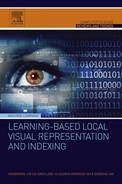Preface
The visual local representation model based on local features and visual vocabulary serves as a fundamental component in many existing computer vision systems. It has widespread application in the fields of object recognition, scene matching, multimedia content search and analysis, and also is the ad hoc focus of current computer vision and multimedia analysis research. The pipeline of the visual local representation model is to first extract the local interest points from images, then quantize such points into visual vocabulary, which forms a quantization table to obtain the feature-space division into visual words. Subsequently, each image is represented as a bag-of-visual-words descriptor, and is inverted indexed into all its corresponding visual words. Research on current computer vision systems have shown that local visual representation models have sufficient robustness against scale and affine transforms and are good at handling partial object occlusion and matching.
However, recent research has also discovered that there are problems in the state-of-the-art visual local representation models, i.e., insufficient visual content discriminability, extreme dense representation, as well as an inability to reveal higher-level semantics. This book focuses on the study of local feature extraction, quantization errors and semantic discriminability in visual vocabulary, as well as the visual quantization errors, semantic discriminability during the visual vocabulary construction, and the visual phrase based visual vocabulary representation problem.
In the local feature extraction, both spatial and category contexts are exploited, which puts forward the interest-point detection from a local scope toward a global scope. In the unsupervised learning of visual vocabulary and its indexing, the quantization errors in the traditional visual vocabulary are investigated, which further reveals the difference between visual words and textual words, and the influence of narrowing this difference. In the supervised learning of visual vocabulary and its indexing, the image labels are introduced to supervise the visual vocabulary construction, which achieves learning-based quantization in local feature space. Finally, based on the optimized visual vocabulary model, the extension from visual words to visual phrases is investigated, together with its usage and combination manners with the traditional bag-of-visual-words representation. The main contents of this book are as follows.
In the stage of interest-point detection, a context-aware semi-local interest-point detector is proposed. This detector integrates maximum outputs in image scale space with spatial correlations for interest-point detection. First, the multiple-scale spatial correlations of local features are integrated into a difference of contextual Gaussian (DoCG) field. Experiments have revealed that it can fit the global saliency analysis results to a certain degree. Second, the mean shift algorithm is adopted to locate the detection results within the difference of contextual Gaussian field, in which the training labels are also integrated into the mean shift kernels to enable the finding of “interest” points for subsequent classifier training.
In the stage of unsupervised learning for constructing visual vocabulary and its indexing, a density-based metric learning is proposed for unsupervised quantization optimization. First, using fine quantization in informative feature space and coarse quantization in uninformative feature space, the quantization errors in visual vocabulary construction are minimized, which produces more similar distribution from visual words to textual words. Second, a boosting chain-based hierarchical recognition and voting scheme is proposed, which improves the online recognition efficiency while maintaining its effectiveness and discriminability.
In the state of supervised visual vocabulary learning, a semantic embedding-based supervised quantization approach is proposed. This approach introduces the image labels from the web to build the semantic sensitive visual vocabulary. First, a feature-space density-diversity estimation algorithm is introduced to propagate the image labels from image level into local feature level. Second, the supervised visual vocabulary construction is modeled into a hidden Markov random field, in which the observed field models the local feature set, while the hidden field models the user label supervision. The supervision in the hidden field is achieved via Gibbs distribution over the observed field, and the vocabulary construction is treated as a supervised clustering procedure on the observed field. Meanwhile, we adopt WordNet to model the semantic correlations for user labels in the hidden field, which effectively eliminates the labels synonym.
In the stage of visual vocabulary-based representation, a co-location visual pattern mining algorithm is proposed. This algorithm encodes the spatial co-occurrence and correlative positions of local feature descriptors into co-location transactions and leverages Apriori algorithm to mine the co-location visual patterns. Such a pattern is second order and is sensitive to category information, which serves as more discriminative and lower dimensional local visual descriptions. In addition, such sparse representation, together with the original bag-of-visual-words representation, can further improve the visual search precision in visual search and recognition experiments in benchmark databases, which has been proven in quantitative experimental comparisons.
